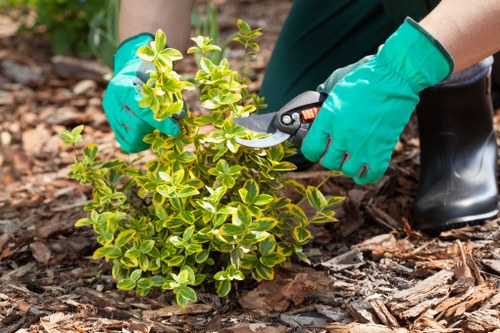Lawn Mowing in Gardener Gardening: Achieving a Perfectly Manicured Lawn

Introduction to Lawn Mowing
Lawn mowing is a fundamental aspect of gardener gardening, playing a crucial role in maintaining the health and appearance of your outdoor space. Regular mowing not only keeps your grass looking neat but also promotes strong and resilient turf. Understanding the best practices for lawn mowing can make a significant difference in the overall vitality of your garden.
Whether you're a seasoned gardener or a novice, mastering the art of lawn mowing can enhance the beauty of your home and provide a pleasant environment for outdoor activities. This comprehensive guide explores various techniques, tools, and tips to help you achieve a lush and sustainable lawn.
From selecting the right mower to understanding the optimal mowing height, we cover all the essential elements that contribute to effective lawn maintenance. By implementing these strategies, you can ensure that your lawn remains healthy, vibrant, and the envy of your neighborhood.

Choosing the Right Lawn Mower
Types of Lawn Mowers
Selecting the appropriate lawn mower is the first step towards efficient lawn care. There are several types of lawn mowers available, each with its own set of advantages and drawbacks. The most common types include:
- Push Mowers: Ideal for small to medium-sized lawns, offering simplicity and ease of use.
- Self-Propelled Mowers: Suitable for larger areas, reducing the physical effort required.
- Riding Mowers: Best for extensive lawns, providing comfort and efficiency for large-scale mowing.
- Robotic Mowers: Automated solutions that offer convenience and precision mowing with minimal intervention.

Factors to Consider When Choosing a Mower
When selecting a lawn mower, it's essential to consider several factors to ensure it meets your specific needs:
- Lawn Size: Larger lawns may benefit from self-propelled or riding mowers, while smaller lawns can be efficiently managed with push mowers.
- Terrain: Uneven or hilly terrain may require mowers with better traction and maneuverability.
- Grass Type: Different grass varieties may need specific mowing heights and techniques.
- Maintenance: Consider the maintenance requirements, including cleaning, blade sharpening, and fuel or battery management.
- Budget: Determine your budget to find a mower that offers the best value within your price range.

Optimal Mowing Practices
Determining the Right Mowing Height
Maintaining the appropriate mowing height is vital for a healthy lawn. Different grass types thrive at various heights:
- Bermuda Grass: Best maintained at 1-2 inches.
- Fescue Grass: Optimal height is 2.5-3.5 inches.
- Zoysia Grass: Ideal at 1.5-2.5 inches.
- St. Augustine Grass: Should be kept at 2.5-4 inches.
Setting your mower to the correct height ensures that the grass can develop a robust root system, resist weeds, and recover quickly from mowing.
Mowing Frequency and Timing
The frequency of mowing depends on the growth rate of your grass and the seasonal changes. As a general rule:
- Spring and Summer: Mow once a week to keep up with rapid growth.
- Fall: Reduce mowing frequency as growth slows.
- Winter: Mowing may be unnecessary, depending on your climate.
It's best to mow in the late morning or early evening when the grass is dry, reducing the risk of disease and ensuring a cleaner cut.

Maintaining Your Lawn Mower
Regular Cleaning and Inspection
Keeping your lawn mower in optimal condition requires regular maintenance. After each use, clean the mower deck to remove grass clippings and debris that can cause rust or affect performance. Inspect the blades for dullness or damage, sharpening them as needed to ensure a clean cut.
Proper Storage
Storing your mower in a dry, sheltered location protects it from the elements and extends its lifespan. For gas-powered mowers, consider draining the fuel or adding a stabilizer to prevent engine issues. Electric mowers should have their batteries removed and stored according to the manufacturer's recommendations.
Seasonal Maintenance
Conduct a thorough check of your mower before the mowing season begins. Replace any worn parts, check oil levels, and ensure that all components are functioning correctly. Regular maintenance not only prolongs the life of your mower but also ensures that it operates efficiently when you need it most.
Eco-Friendly Lawn Mowing Practices
Reducing Environmental Impact
Adopting eco-friendly mowing practices contributes to a healthier environment and a more sustainable garden. Here are some strategies to minimize your ecological footprint:
- Use a Reel Mower: Electric or manual reel mowers produce zero emissions and are quieter than gas-powered alternatives.
- Mow at Higher Heights: Taller grass shades the soil, reducing water evaporation and inhibiting weed growth.
- Leave Clippings on the Lawn: Grass clippings act as natural fertilizer, returning nutrients to the soil and reducing the need for chemical fertilizers.
- Limit Mowing Frequency: Allowing the grass to grow slightly longer can enhance its resilience and reduce the number of times you need to mow.
Water Conservation Techniques
Proper mowing techniques can also aid in conserving water. By maintaining an optimal grass height, you ensure that the roots can access moisture more effectively, reducing the need for frequent watering. Additionally, mowing when the grass is dry prevents water loss through evaporation.
Choosing Sustainable Equipment
Investing in energy-efficient lawn mowers, such as battery-powered or solar-assisted models, can significantly reduce your carbon footprint. These mowers offer the same performance as traditional models without the harmful emissions, making them a responsible choice for environmentally conscious gardeners.
Advanced Lawn Mowing Techniques
Pattern Mowing
Varying the mowing pattern each time you mow prevents the grass from developing a rut and encourages upright growth. Common patterns include:
- Diagonal Mowing: Creates a dynamic appearance and helps distribute wear evenly.
- Circular Mowing: Ideal for small lawns, providing a uniform look.
- Striped Mowing: Enhances the aesthetic appeal with visible stripes, often achieved by using a reel mower.
Bagging vs. Mulching
Deciding whether to bag or mulch your grass clippings depends on your lawn's needs:
- Bagging: Removes clippings, ideal for lawns susceptible to thatch buildup.
- Mulching: Returns nutrients to the soil, promoting healthy growth and reducing the need for additional fertilizers.
Many modern mowers offer a mulching feature, allowing you to choose based on seasonal requirements and lawn conditions.
Dealing with Lawn Pests and Diseases
Regular mowing can help prevent common lawn pests and diseases by removing weak or affected grass portions. However, it's essential to stay vigilant and address any issues promptly:
- Aeration: Improve soil health and reduce compactness, making it harder for pests to thrive.
- Proper Mowing Height: Maintain an optimal height to discourage pests and prevent disease spread.
- Integrated Pest Management: Use natural predators and minimal chemical interventions to control pest populations.
Benefits of Professional Lawn Mowing Services
Expertise and Efficiency
Hiring professional lawn mowing services can offer numerous advantages, including:
- Time Savings: Professionals handle the mowing, allowing you to focus on other tasks or enjoy your free time.
- Quality Results: Experienced landscapers ensure precise and consistent mowing, enhancing the overall appearance of your lawn.
- Customized Care: Professionals can tailor their services to your lawn's specific needs, addressing unique challenges effectively.
Equipment and Resources
Professional lawn care providers invest in high-quality equipment and stay updated on the latest mowing techniques. This ensures that your lawn receives top-notch care, promoting healthy growth and a polished look.
Ongoing Maintenance and Support
Beyond mowing, professional services often include additional maintenance tasks such as fertilization, aeration, and pest control. This comprehensive approach ensures that your lawn remains healthy and vibrant throughout the year.
DIY Lawn Mowing Tips for Enthusiastic Gardeners
Planning Your Mowing Schedule
Creating a mowing schedule helps maintain consistency and ensures that your lawn receives the attention it needs. Consider the following steps:
- Assess Growth Rates: Monitor how quickly your grass grows during different seasons to determine the ideal mowing frequency.
- Set Reminders: Use calendars or digital apps to track your mowing days and stay on schedule.
- Adjust for Weather: Modify your schedule based on rainfall and temperature changes to prevent over or under-mowing.
Maintaining Proper Mower Hygiene
Keeping your mower clean is essential for its performance and longevity. After each use, perform the following maintenance tasks:
- Remove Grass Clippings: Clear the mower deck of clippings to prevent clogs and uneven cutting.
- Check for Debris: Inspect the mower for foreign objects like stones or sticks that could cause damage.
- Lubricate Moving Parts: Apply lubricant to ensure smooth operation of blades and other components.
Sharpening Mower Blades
Dull blades can tear grass instead of cutting it cleanly, leading to stress and potential disease. Sharpen your mower blades regularly by following these steps:
- Disconnect the Spark Plug: Ensure safety by removing the spark plug before starting maintenance.
- Remove the Blade: Follow the manufacturer's instructions to safely detach the blade.
- Sharpen the Blade: Use a file or a grinder to sharpen the cutting edge, maintaining the proper angle.
- Reattach the Blade: Securely fasten the sharpened blade back onto the mower, ensuring it is balanced and properly aligned.
Enhancing Lawn Health Through Mowing
Promoting Strong Root Systems
Proper mowing practices encourage the development of deep and robust root systems. By cutting the grass at the right height, you allow the roots to grow downward in search of nutrients and water, enhancing the lawn's resilience against drought and pests.
Reducing Weed Growth
Mowing your lawn regularly helps to suppress weed growth by eliminating weak and vulnerable grass areas that weeds can exploit. Maintaining a dense and healthy turf reduces the space available for weeds to establish.
Improving Soil Health
Grass clippings, when left on the lawn as mulch, decompose and enrich the soil with essential nutrients. This natural fertilization process improves soil structure, moisture retention, and overall fertility, contributing to a thriving lawn.
Key Benefits:
- Enhanced nutrient cycling
- Better water retention
- Improved soil aeration
- Increased microbial activity
Long-Term Advantages
Consistent and mindful mowing practices not only provide immediate aesthetic benefits but also ensure long-term lawn health and sustainability. Investing time and effort into proper mowing techniques pays dividends in the form of a beautiful and enduring green space.
Common Lawn Mowing Mistakes to Avoid
Mowing Too Short
Cutting the grass too short, known as scalping, exposes the soil and weakens the grass, making it more susceptible to weeds, pests, and drought. It is essential to adhere to the recommended mowing height for your specific grass type.
Mowing Wet Grass
Mowing when the grass is wet can lead to uneven cuts, clumping, and increased risk of disease. Always wait until the grass is dry before mowing to ensure a clean and efficient cut.
Neglecting Regular Maintenance
Failing to maintain your mower, such as not sharpening blades or cleaning the deck, can result in poor cutting performance and damage to your lawn. Regular maintenance ensures that your equipment functions correctly and prolongs its lifespan.
Ignoring Edges and Borders
For a polished and professional look, pay attention to the edges and borders of your lawn. Use trimmers or edge cutters to maintain clean lines around sidewalks, driveways, and garden beds.
Incorrect Mowing Pattern
Using the same mowing pattern repeatedly can lead to uneven grass growth and rutting. Varying your mowing pattern helps distribute wear evenly and promotes upright grass blades.
Lawn Mowing Tools and Accessories
Essential Tools
Having the right tools can make lawn mowing more efficient and enjoyable. Essential tools include:
- A Reliable Lawn Mower: Choose a mower that suits your lawn size and terrain.
- String Trimmer: Ideal for trimming edges and hard-to-reach areas.
- Lawn Edger: Provides clean and defined borders for a neat appearance.
- Mower Deck Brush: Helps clean the mower deck after each use.
Safety Equipment
Safety should always be a priority when mowing the lawn. Equip yourself with the following protective gear:
- Safety Glasses: Protect your eyes from debris and grass clippings.
- Ear Protection: Reduce noise exposure, especially when using loud mowers.
- Gloves: Prevent hand injuries and provide a better grip on tools.
- Steel-Toe Boots: Protect your feet from potential hazards.
Additional Accessories
Enhance your mowing experience with these useful accessories:
- Mower Cover: Shields your mower from the elements, extending its lifespan.
- Mulching Kit: Converts your mower into a mulching machine for eco-friendly lawn care.
- Lawn Mower Bagging System: Collects grass clippings for easy disposal or composting.
- Blade Sharpening Tool: Keeps your mower blades sharp for a clean cut.
Seasonal Lawn Mowing Tips
Spring Mowing
As your lawn wakes up from winter dormancy, spring is the time to kickstart your mowing routine. Begin by:
- Removing Debris: Clear fallen leaves and branches to prepare the lawn for mowing.
- Initial Trim: Set your mower to a higher height to avoid stressing new growth.
- Fertilizing: Apply a balanced fertilizer to promote healthy spring growth.
Summer Mowing
During the hot summer months, your lawn may grow more rapidly. Adjust your mowing practices by:
- Raising Mower Height: Taller grass shades the soil, reducing water evaporation.
- Watering Appropriately: Water deeply but less frequently to encourage deep root growth.
- Monitoring for Pests: Keep an eye out for signs of lawn pests and address issues promptly.
Fall Mowing
As temperatures begin to drop, prepare your lawn for the winter by:
- Gradually Lowering Mower Height: Transition to a shorter height to prevent matting under snow.
- Removing Leaves: Keep the lawn free from fallen leaves that can harbor pests and diseases.
- Aerating the Soil: Improve soil health and prepare the lawn for the next growth cycle.
Winter Lawn Care
In regions with cold winters, lawn mowing may take a backseat. However, you can still maintain your lawn by:
- Final Mow: Give your lawn a last trim before the first frost.
- Protecting from Frost: Avoid walking on frozen grass to prevent damage.
- Planning for Next Year: Assess your lawn's condition and plan any necessary improvements.
Conclusion: The Importance of Regular Lawn Mowing
Regular lawn mowing is more than just an aesthetic task; it's a vital component of lawn health and maintenance. By adhering to the best practices outlined in this guide, you can ensure that your lawn remains lush, resilient, and visually appealing throughout the year.
Whether you choose to mow your lawn yourself or enlist the help of professional services, understanding the key principles of lawn mowing will empower you to make informed decisions and achieve the best possible results. Embrace the art of lawn mowing and transform your garden into a beautiful and sustainable outdoor haven.
Take Action Today
Ready to elevate your lawn care routine? Contact us today to learn more about our expert lawn mowing services and how we can help you achieve the perfect lawn you've always desired. Book your service now and enjoy a pristine garden all year round!



